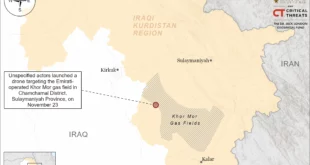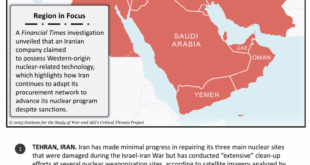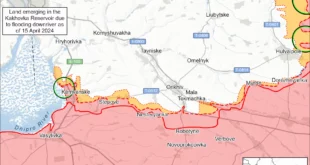The following remarks were delivered by Christian Saunders, the Senior Defense Intelligence Analyst for Iran, Defense Intelligence Agency.
Today, the Defense Intelligence Agency presents Iran Military Power, a report that examines the core capabilities of Iran’s military. This publication is part of DIA’s series of unclassified military reports that provide details on foreign military intent, strategy and capabilities. This report examines Iran’s military strategy and goals, the organization’s structure and capability of the military that supports those goals, as well as the enabling infrastructure and industrial base.
The Military Power Series is designed to help the public achieve a deeper understanding of key challenges and threats to U.S. national security and the security of our partners and our allies. The department requires a sophisticated understanding of foundational military intelligence, and DIA produces extensive military capability studies at all levels of classification, and various levels of detail provide this insight to all constituencies and stakeholders.
We have a long history of producing comprehensive and authoritative defense intelligence overviews at the unclassified level. DIA first published the unclassified Soviet Military Power Report in 1981. We renewed the publication of these unclassified military studies in June of 2017 with Russia Military Power, and earlier this year with China Military Power, and today we’re turning to Iran.
Throughout its 40-year history the Islamic Republic of Iran has remained opposed to the United States and our presence in the Middle East. Iran projects its military power through two different military institutions: the regular forces, or Artesh, and the Islamic Revolutionary Guard Corps, or the IRGC. These organizations serve two important strategic goals for Iran: first, the survival of the regime; and second, securing a dominant position in the region.
Iran employs a hybrid approach to warfare using both conventional and unconventional elements. On the conventional side, Iran’s military strategy is primarily based on deterrence and the ability to retaliate against an attacker. Iran also uses unconventional warfare operations and a network of militant partners and proxies to enable Tehran to advance its interests in the region, as well as attain strategic depth.
The Iranian military largely relies on three core capabilities: first is ballistic missiles; the second are naval forces capable of threatening navigation in the Persian Gulf and the Strait of Hormuz; and the third is unconventional capabilities including the use of partners and proxies abroad.
First we’ll turn to ballistic missiles. Iran’s ballistic missiles constitute a primary component of its strategic deterrent. Lacking a modern air force, Iran has embraced ballistic missiles as a long-range strike capability to dissuade its adversaries from attacking Iran. Iran also has the largest missile force in the Middle East, with substantial inventory of close-range ballistic missiles, short-range ballistic missiles and medium-range ballistic missiles that can strike targets throughout the region as far as 2,000 kilometers away. Iran will deploy an increasing number of more accurate and lethal theater ballistic missiles, improve its existing missile inventory and also field new land attack cruise missiles. Iran’s developments of its space launch vehicle program could also serve as the test bed for the development of intercontinental ballistic missile technologies.
Secondly, Iran’s naval capabilities emphasize an anti-access area denial strategy. Benefiting from Iran’s geostrategic position along the Persian Gulf and the Strait of Hormuz, Iran’s layered maritime capabilities emphasize asymmetric tactics using numerous platforms and weapons intended to overwhelm an adversary’s naval force. The full range of these capabilities includes ship- and shore-launched anti-ship cruise missiles, small boats, naval mines, submarines, unmanned aerial vehicles, anti-ship ballistic missiles and air defenses.
Iran’s use of partners, proxies and unconventional warfare is central to its regional influence and deterrent strategy. The IRGC Qods Force, Iran’s primary tool for unconventional operations, maintains a wide network of non-state partners, proxies and affiliates throughout the region. Iran provides a range of financial, political, training and material support to groups which would include Hezbollah, Iraqi Shia militant groups, the Houthis in Yemen, some Palestinian groups, the Taliban and Bahraini Shia militants.
Another point of concern to the United States and our allies is Iran’s rapid progress in advancing its UAV capabilities. Iran sees these as versatile platforms for a variety of missions, including Intelligence, Surveillance and Reconnaissance, or ISR, and air-to-ground strikes and has steadily expanded its UAV inventory. Iran has deployed various armed and unarmed UAVs to Syria and Iraq for ISR and strike missions.
Iran is also strengthening its integrated air defense systems through domestic production as well as foreign acquisition. Iran is fielding more capable domestically developed surface to air missiles and radar systems, and in 2016, acquired the Russian SA-20C air defense system, which provided Iran with its first capability to defend itself against a modern Air Force.
In the cyber domain, Tehran views cyberspace operations as a safe, low-cost method to collect information and retaliate against perceived threats, and Iran’s regime is continuing to improve its cyber capabilities.
Iran has no nuclear weapons but its nuclear program remains a significant concern for the United States. Earlier this year, Iran began a counter-U.S. maximum pressure campaign, which has included gradually exceeding some of the nuclear related limits stipulated in the Joint Comprehensive Plan of Action, or JCPOA. In early July 2019, the IAEA first confirmed that Iran had exceeded some of its JCPOA limits. Tehran has threatened to continue ceasing other JCPOA commitments unless it released – unless it receives sufficient sanctions relief.
Iran’s military strategy, as I said earlier, is focused on deterrence and is unlikely to change considerably in the near term, but Iran has taken steps towards developing a limited expeditionary capability through its operations in Syria and Iraq.
The IRGC Qods Force and its network of proxies will remain critical to Iran’s military power and Tehran will also improve its conventional forces in seeking new capabilities. Iran’s current modernization plans emphasize a broader range of conventional capabilities than in the past.
Iran probably will continue to focus on the domestic development of increasingly capable missiles, naval platforms and weapons, and air defenses while it attempts to upgrade some of its deteriorating air and ground capabilities primarily through foreign purchases.
Under U.N. Security Resolution 2231, Iran is prohibited from procuring most types of conventional weapons systems from abroad. However, these restrictions are set to expire in October 2020, providing Tehran an opportunity to acquire some advanced capabilities that have been beyond its reach for decades.
As Tehran expands its capabilities in role as both an unconventional and conventional threat in the Middle East, it is more important than ever that we understand Iran’s military power and the threat it poses to our interests, our allies and our security
 Eurasia Press & News
Eurasia Press & News


